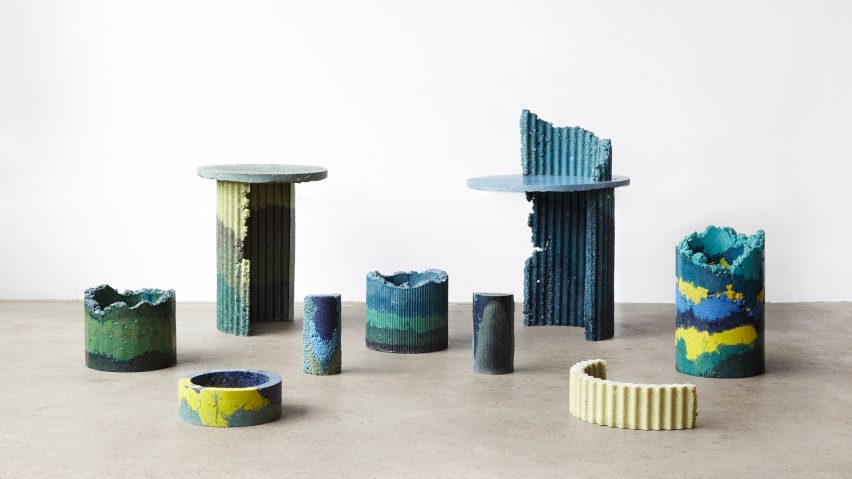London-based designer Charlotte Kidger gives new life to polyurethane foam dust by turning it into multi-coloured pieces of furniture.
Kidger's Industrial Craft collection makes use of the by-products of computer numerical control (CNC) fabrication by using them to make textured tables, stools and a number of vessels in a range of cool tones.
As the designer explains, the CNC milling process produces a large volume of excess lightweight polyurethane foam dust. As it is an unusual plastic, it isn't recycled, so its only means of disposal is through incineration or landfill.
The designer wanted to see if she could find ways of repurposing this "undervalued and problematic" material.
The result was a durable and versatile composite material made from 70 per cent waste polyurethane foam dust and 30 per cent resin, which acts as a binder. The material has the potential to be cast in a range of three-dimensional forms of various scales.
Her hope is that this innovative use of industrial waste will encourage others to place more value on what is normally considered waste, and consequently discarded.
"This new composite base material provides exciting opportunities for further design applications, as well as finding a permanent solution to the original waste stream," said Kidger.
"With a zero-waste process in the making of my sculptural objects, and with strong focus on durability, I aim to have created an alluring yet functional use for the material," she added.
According to Kidger, she treated the material in the same way as she might wood. Once cast, she could cut, sand and engrave it, and return it to the CNC machine.
"The beauty of the process involved with working with this composite material means each outcome is unique and bespoke," she said.
"For example, although I can use the same mould to cast multiples of the same form, each will come out slightly different due to the curing process during casting."
"These often-unexpected reveals can create interesting defects that add new layers to the material's qualities; I believe this adds value to the objects I create by blurring a boundary between craft and industrial manufacturing," she added.
The furniture will be showcased as part of London Design Festival, which takes place this year from 18 to 23 September 2018.
It will also be exhibited at London Design Fair 2018 at the Old Truman Brewery from 20 to 23 September, which will celebrate plastic as the material of the year. The exhibition – Plastic, Beyond the Chipper – will focus on the reuse of plastics within the design industry, presenting four designers who treat plastic waste as a virgin material to give it a new worth.
"Industrial craft is as much about exploiting the possibility of material answers as it is about asking questions. I believe this material and the objects represent both sustainability and innovation," she continued.
"Through working with an abundant source of waste material taken from the creativity of other designers, I hope to have found an innovative solution to utilising this waste stream."
The work of Japanese designer Kodai Iwamoto will also be displayed in this show alongside Kidger's work. His Plastic Blowing project sees him combine glass-blowing techniques with cheap, readily available PVC pipes to make unusual plastic vases.

